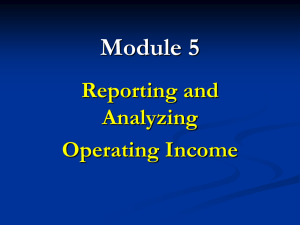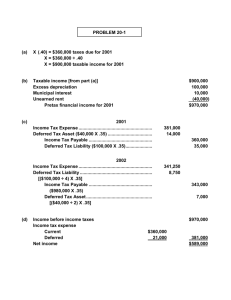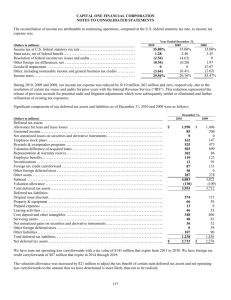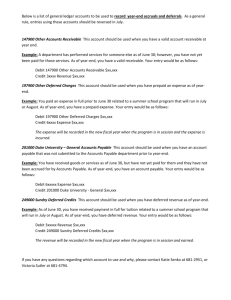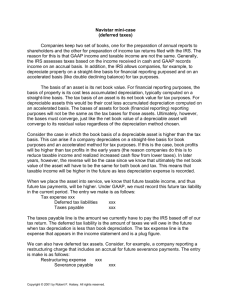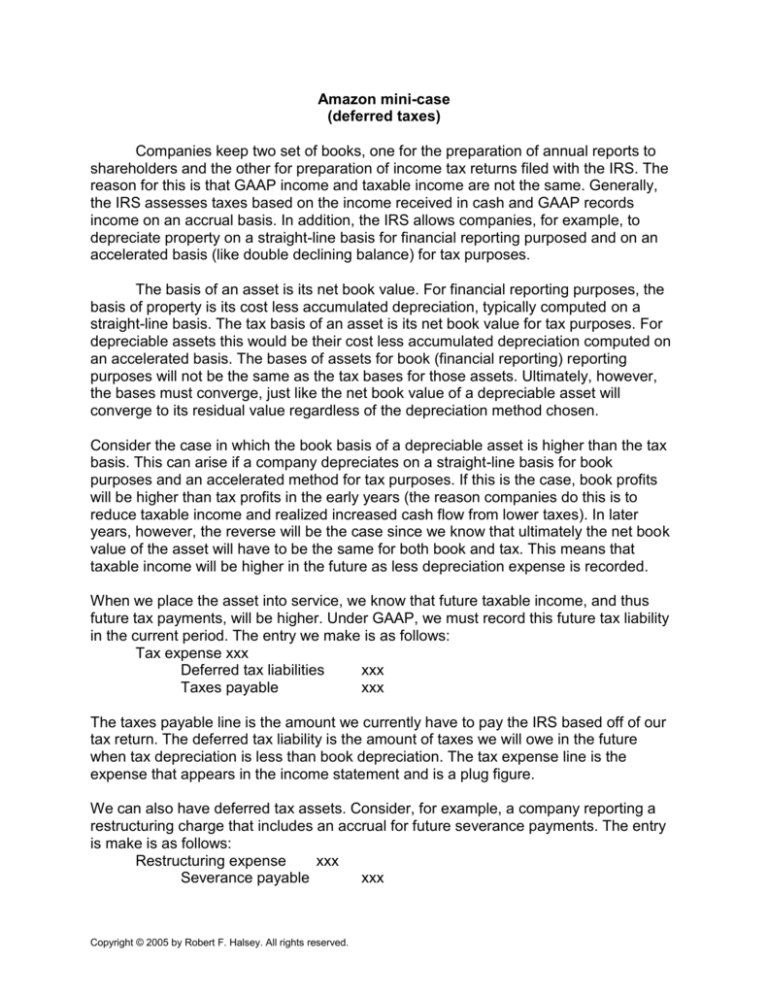
Amazon mini-case
(deferred taxes)
Companies keep two set of books, one for the preparation of annual reports to
shareholders and the other for preparation of income tax returns filed with the IRS. The
reason for this is that GAAP income and taxable income are not the same. Generally,
the IRS assesses taxes based on the income received in cash and GAAP records
income on an accrual basis. In addition, the IRS allows companies, for example, to
depreciate property on a straight-line basis for financial reporting purposed and on an
accelerated basis (like double declining balance) for tax purposes.
The basis of an asset is its net book value. For financial reporting purposes, the
basis of property is its cost less accumulated depreciation, typically computed on a
straight-line basis. The tax basis of an asset is its net book value for tax purposes. For
depreciable assets this would be their cost less accumulated depreciation computed on
an accelerated basis. The bases of assets for book (financial reporting) reporting
purposes will not be the same as the tax bases for those assets. Ultimately, however,
the bases must converge, just like the net book value of a depreciable asset will
converge to its residual value regardless of the depreciation method chosen.
Consider the case in which the book basis of a depreciable asset is higher than the tax
basis. This can arise if a company depreciates on a straight-line basis for book
purposes and an accelerated method for tax purposes. If this is the case, book profits
will be higher than tax profits in the early years (the reason companies do this is to
reduce taxable income and realized increased cash flow from lower taxes). In later
years, however, the reverse will be the case since we know that ultimately the net book
value of the asset will have to be the same for both book and tax. This means that
taxable income will be higher in the future as less depreciation expense is recorded.
When we place the asset into service, we know that future taxable income, and thus
future tax payments, will be higher. Under GAAP, we must record this future tax liability
in the current period. The entry we make is as follows:
Tax expense xxx
Deferred tax liabilities
xxx
Taxes payable
xxx
The taxes payable line is the amount we currently have to pay the IRS based off of our
tax return. The deferred tax liability is the amount of taxes we will owe in the future
when tax depreciation is less than book depreciation. The tax expense line is the
expense that appears in the income statement and is a plug figure.
We can also have deferred tax assets. Consider, for example, a company reporting a
restructuring charge that includes an accrual for future severance payments. The entry
is make is as follows:
Restructuring expense
xxx
Severance payable
xxx
Copyright © 2005 by Robert F. Halsey. All rights reserved.
The company, thus, reports the expense for book purposes currently when the liability is
incurred. For tax purposes, however, the expense is not a deduction until the severance
payments are actually paid. In this case, book income is less than tax income. We
know, however, that we will have a future deduction when the payments are made. This
is a future tax benefit and meets the test of an asset. So, we record a deferred tax
asset. Deferred tax assets reduce current the tax expense reported for book purposes
with the following entry:
Tax expense
xxx
Deferred tax asset xxx
Tax payable
xxx
Companies can have both deferred tax assets and deferred tax liabilities. The amount
of expense reported in the company’s income statement will depend on 1. the amount
of tax payable (current portion) and the changes in deterred tax assets and liabilities
(deferred portion). This mini-case is designed to give you an introduction into deferred
taxes. We will use the Amazon 2004 annual report for this exercise, portions of which
follow. Please answer the following questions:
1. How much pre-tax profit, tax expense, and net income did the company report
for 2004?
2. For its tax expense, how much is currently payable and how much is due to
changes in deferred tax assets and liabilities?
3. What deferred tax assets and liabilities does the company report in total? Are
the assets and liabilities reported separately or netted on the balance sheet?
4. What are the major categories of deferred tax assets and liabilities? How might
these arise?
5. The company reports net operating loss carry forwards. Generally, these relate
to taxable losses that, under the IRS code, can be carried forward to future
years to reduce taxable income in those years. If it is unlikely that the NOL’s will
be used before they expire, the company must set up a valuation allowance to
reduce the deferred tax asset, just like the allowance for doubtful accounts.
What will be the effect on current profitability if a company establishes a deferred
tax asset valuation allowance?
6. What changes does Amazon report in its deferred tax valuation allowance
account for 2004? Describe what prompted the change and the effect the
change had on its reported income?
7. As an analyst, how should you view deferred tax asset valuation accounts?
8. In general, for growing manufacturing companies that typically report a large
deferred tax liability, how should you view the deferred tax asset or liability? That
is, does the liability represent a future cash outflow? Under what circumstances?
Copyright © 2005 by Robert F. Halsey. All rights reserved.
Copyright © 2005 by Robert F. Halsey. All rights reserved.
Copyright © 2005 by Robert F. Halsey. All rights reserved.
Copyright © 2005 by Robert F. Halsey. All rights reserved.
Copyright © 2005 by Robert F. Halsey. All rights reserved.
Copyright © 2005 by Robert F. Halsey. All rights reserved.
Copyright © 2005 by Robert F. Halsey. All rights reserved.

